
Alaska Department of Health & Social Services Weekly Case Update
March 28-April 3, 2021
Increasing Statewide transmission | HIGH Statewide alert status | Adequate Hospital capacity | Moderate Test positivity | 45.23% |
Red- quickly increasing, Rt>1.2 | Red- 14-day average case rate per 100,000 people >10 | Red- <3 weeks until beyond capacity Yellow- >6 weeks | Red->5% Orange- 2-5% Yellow- <2% | At least one shot Estimated AK population 16 and older of 569,699 from census.gov (American Community Survey 2019) |
Brief Status Report
- Virus transmission increased for the second consecutive week with higher case rates and test positivity. Anchorage, Fairbanks, and the Matanuska-Susitna regions saw a sustained rise in case rates, while Juneau, Kenai Peninsula, Northern Southeast, and Southern Southeast regions had higher rates than last week.
- Anyone 16 years or older who lives or works in Alaska is eligible to receive a COVID-19 vaccine. Alaska was the first state to offer vaccines to everyone over a certain age without prerequisites.
- More vaccinations lead to fewer COVID-19 infections, illnesses, hospitalizations, and deaths. Vaccinations are the key to ending this pandemic.
- Alaska is currently the fourth most vaccinated state per capita. 48.25% of the State/IHS vaccine allocation so far has been administered.
- DHSS encourages all Alaskans who are currently eligible for COVID-19 vaccination to make appointments as soon as possible by visiting covidvax.alaska.gov or by calling 1-907-646-3322. The call line is staffed Monday-Friday from 9AM-6:30PM and 9AM-4:30PM on weekends. The call line can also be used to answer general questions about vaccine safety and to request appointments to receive a specific type of vaccine. Alaskans receiving health services through a Tribal Health Organization or the Department of Defense should contact those organizations directly to determine their eligibility.
- One new case of a COVID variant of concern was detected in Alaska during the past week.
What Alaskans Can Do
- Every Alaskan who chooses to get vaccinated, wear a mask, stay 6 feet from others, and avoid indoor gatherings helps protect themselves and the health of all Alaskans. These are our best tools to decrease the chance of a new variant entering Alaska and spreading.
- Fully vaccinated people can visit with other fully vaccinated people indoors without wearing masks or socially distancing. They can also visit with unvaccinated people from a single household who are at low risk for severe COVID-19 without wearing masks or socially distancing. Vaccinated people can also refrain from quarantine and testing following a known exposure to someone with COVID-19 so long as the vaccinated person is asymptomatic. We expect that CDC guidelines for people who have been vaccinated will continue to be updated as new evidence becomes available.
- To stop COVID-19, including new strains of virus, from coming into Alaska and spreading, testing within 72 hours before returning to Alaska or on arrival and then strict social distancing until the test result is available is recommended. A second test 5-14 days after arrival is also recommended if the traveler is not fully vaccinated. As of Jan 26, 2021, the CDC requires international travelers to show proof of a negative test from within the last 72 hours on arrival back in the US.
- CDC guidelines recommend regular asymptomatic testing for critical infrastructure workers and other groups at higher risk for COVID-19.
- Alaskans should get tested immediately at the first sign of any symptoms. Tests work best when obtained promptly after symptoms start. Testing early helps people know if they are positive quickly and helps prompt them to take immediate precautions to minimize the risk of transmitting the virus to others.
- Most Alaskans get COVID-19 from a friend, family member, or coworker. Many Alaskans who are diagnosed with COVID-19 report that they went to social gatherings, community events, church services, and other social venues while they were contagious but before they knew they had the virus.
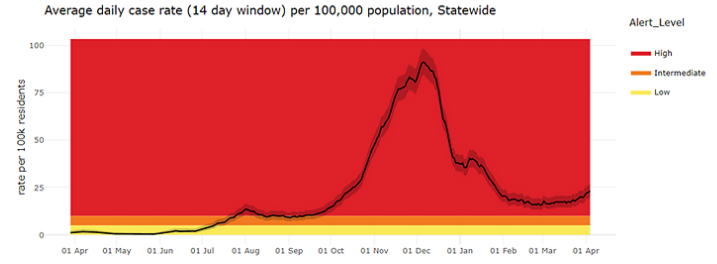
Case Trends and Predictions
- 1,160 cases were reported in Alaskans last week. This was a 6.2% decrease from the week before, however it is the second straight week of rising rates in the Anchorage, Fairbanks, and Matanuska-Susitna Regions.
- 14-day average daily case rates were similar or higher in most regions of Alaska compared with last week. The Anchorage case rate increased from 22.0 last week to 25.7 this week. This is the highest case rate since mid-January. Fairbanks North Star Borough increased from 13.7 to 16.2 this week. Case rates in Matanuska-Susitna Region continued to rise to 49.2, the highest level this region has seen in 2021.
- The Northwest Region decreased to from 4.5 to 3.2. The Interior Region except Fairbanks decreased from 40.9 to 30.0.
- Case rates increased in Kenai Peninsula Borough, from 6.7 to 11.8, Northern Southeast Region from 6.3 to 7.4, Southern Southeast Region from 4.7 to 5.4, and Juneau City from 3.8 to 5.4. Case rates slightly decreased in Northwest Region from 4.5 to 3.2.
- The Yukon-Kuskokwim Delta Region daily case rate decreased for a second week to from 26.4 to 25.9.
- The estimated statewide daily growth rate as of April 5, 2021 is 0.9% and new cases are expected to double every 77.2 days based on current modeling.
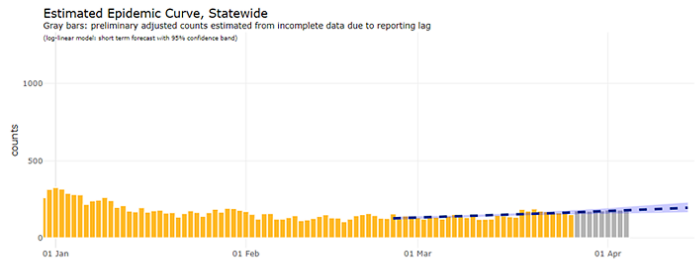
< Continued >
Regional Case Trends
Behavioral Health Region | Case rates Feb 21–Feb 27 | Case rates Feb 28–Mar 6 | Case rates Mar 7– Mar 13 | Case rates Mar 14– Mar 20 | Case rates Mar 21– Mar 27 | Case rates Mar 28– Apr 3 |
Anchorage Municipality | 12.6 | 15.0 | 16.5 | 16.6 | 22.0 | 25.7 |
Fairbanks North Star Borough | 15.0 | 15.1 | 13.7 | 11.7 | 13.7 | 16.2 |
Interior Region except Fairbanks | 15.0 | 13.0 | 30.0 | 47.1 | 40.9 | 30.0 |
Juneau City and Borough | 8.5 | 5.8 | 6.3 | 4.3 | 3.8 | 5.4 |
Kenai Peninsula Borough | 5.7 | 6.8 | 7.6 | 6.2 | 6.7 | 11.8 |
Matanuska-Susitna Region | 35.9 | 36.5 | 38.5 | 36.7 | 40.9 | 49.2 |
Northern Southeast Region | 27.0 | 32.6 | 17.2 | 6.0 | 6.3 | 7.4 |
Northwest Region | 4.2 | 4.0 | 4.7 | 5.3 | 4.5 | 3.2 |
Southern Southeast Region | 18.4 | 9.0 | 6.1 | 4.0 | 4.7 | 5.4 |
Southwest Region | 4.8 | 4.5 | 4.3 | 5.3 | 5.6 | 5.1 |
Yukon-Kuskokwim Delta Region | 21.5 | 16.2 | 29.7 | 34.1 | 26.4 | 25.9 |
Statewide | 16.0 | 16.8 | 17.8 | 17.3 | 20.1 | 23.5 |
Vaccines Status Update

Reported vaccinations as of April 5, 2021.
- The State of Alaska is working with federal, local, Tribal, and military partners to ensure that the distribution of vaccine goes as quickly and smoothly as possible.
- Anyone 16 years or older who lives or works in Alaska is eligible to receive a COVID-19 vaccine. All registration for vaccines should go through the registration system on covidvax.alaska.gov . Appointments can also be made by calling 1-907-646-3322. The call line is staffed Monday-Friday from 9AM-6:30PM and 9AM-4:30PM on weekends. The call line can also be used to answer general questions about vaccine safety and to request appointments to receive a specific type of vaccine.
- On April 5, the New York Times vaccination tracker had Alaska as the tenth highest state by percent of the population that has received at least one shot, at 35%, and fourth for population that has received two shots, at 24%. The Alaska vaccine tracker is available online as is a vaccine dashboard for more up-to-date data.
- There is a several day lag in reporting some vaccinations so the dashboard does not yet reflect all vaccinations that have been given.
- Three vaccines are currently available in Alaska: Moderna and Pfizer vaccines are mRNA vaccines. The Johnson & Johnson/Janssen vaccine is an adenovirus-vectored technology.
- There are no plans to mandate a vaccine at the state level.
- More vaccinations lead to fewer COVID-19 infections, illnesses, hospitalizations, and deaths.
- Healthcare providers play a key role in building public confidence in the COVID-19 vaccine. In addition to their roles as health advisers, protectors, and advocates, healthcare personnel were the first group offered COVID-19 vaccinations. Health workers are a trusted voice that can have a powerful influence on their families and communities when it comes to getting the COVID-19 vaccine.
New Cases, Hospitalizations, and Deaths
- During the week of March 28 through April 3, 2021 1,160 cases were reported in Alaskans last week. This is a 6.2% decrease from the week before, for a total of 61,283 cumulative cases reported in Alaskans.
- Cumulative hospitalizations increased to 1,370 with 10 reported as occurring this week. Hospitalization reports often lag and only 1,356 hospitalizations were reported at this time last week, so there are 14 hospitalizations newly reported this week including ones that began during previous weeks.
- No new deaths among Alaska residents were reported this week (309 total). It is common to take more than a week for a death to be reported, and deaths that occurred during Mar 28–Apr 3 may be reported in future as death certificates are reviewed.
- 62 new nonresident cases were identified this week for a total of 2,600 cases.
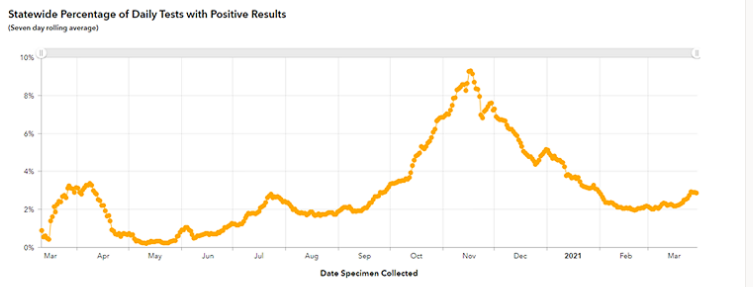
Variant Tracking
1 new COVID variant cases were detected during the week of March 28-April 3
Cumulative list of variants of concern identified in Alaska:
Test date | Patient City | Acquisition | Variant | Week identified |
12/20/2020 | Anchorage | Travel | UK/ B1.1.7 | 1/24-1/30 |
1/13/2021 | Anchorage | Travel | UK/ B1.1.7 | 2/14-2/20 |
2/8/2021 | Anchorage | Community acquired | Brazil/ P.1 | 2/21-2/27 |
2/8/2021 | Anchorage | Secondary | Brazil/ P.1 | 2/28-3/6 |
2/15/2021 | Eagle River | Secondary | Brazil/ P.1 | 2/28-3/6 |
2/15/2021 | Anchorage | Community acquired | Brazil/ P.1 | 2/28-3/6 |
2/15/2021 | Eagle River | Community acquired | Brazil/ P.1 | 2/28-3/6 |
3/11/2021 | Wasilla | Travel | UK/ B1.1.7 | 3/28-4/3 |
- The CDC has added B.1.427 and B.1.429 to the list of variants of concern. Alaska is adjusting surveillance practices and public outputs, however B.1.427 and B.1.429 cases are not currently included in this summary.
- Alaska’s Public Health Laboratories continue to monitor for variants of concern as well as for other variants of interest.
Health Care Capacity
- On April 5, 36 Alaskans with confirmed COVID-19 were hospitalized and 8 were reported to require a mechanical ventilator.
- Hospital staffing can change quickly, particularly if a community has many health workers impacted by COVID-19.
Total Confirmed COVID-19 Beds Occupied

Cases by Week Reported and Age Group
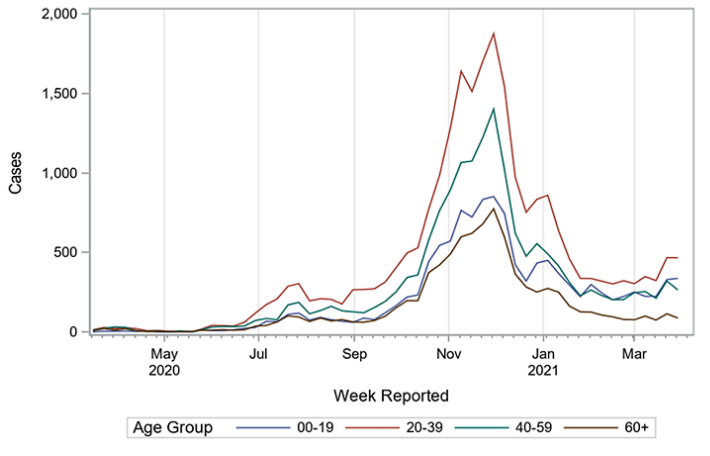
Cases by Week Reported and Race
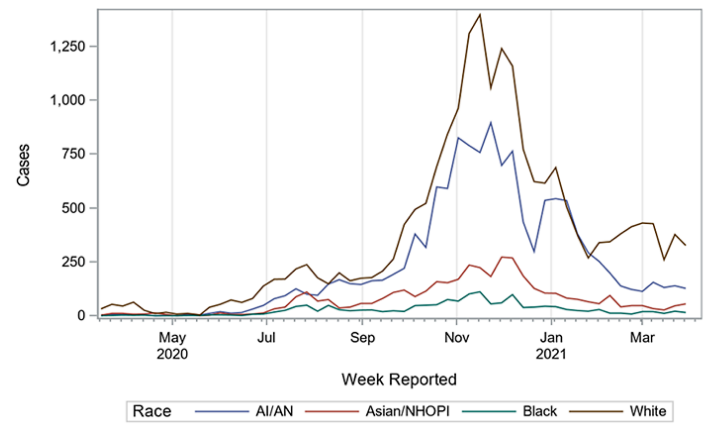
Cases by Week Reported and Region
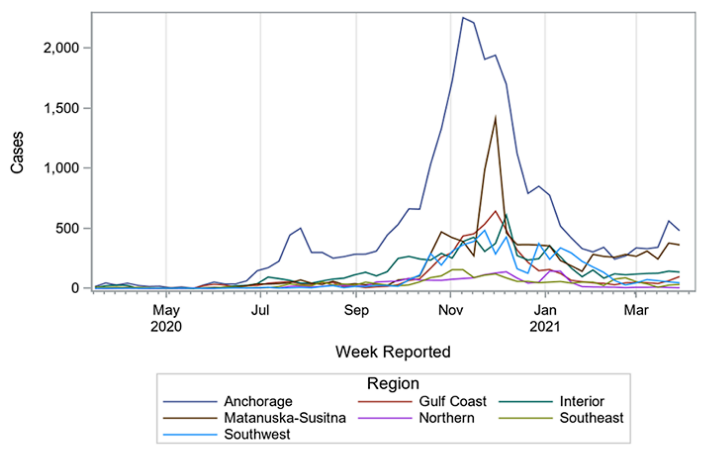
Additional informational resources:
- The State of Alaska COVID-19 vaccine status update page
- The State of Alaska COVID-19 information page provides more information about the virus and how individuals and businesses can protect themselves and others from transmission
- For the most up-to-date case information, see the Alaska Coronavirus Response Hub dashboard: updated Monday – Friday at data.coronavirus.alaska.gov (note: data may change as more information comes to light through contact tracing and other public health work).
- For DHSS media inquiries, please contact clinton.bennett@alaska.gov